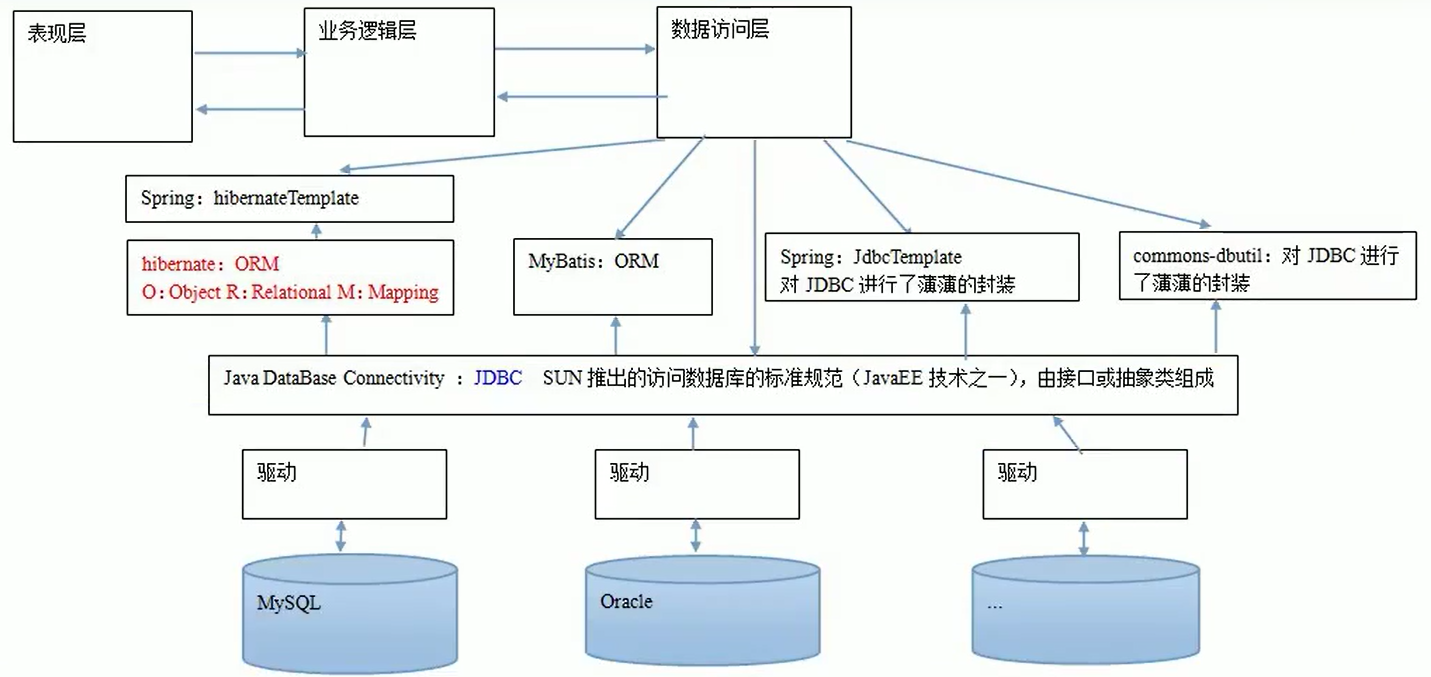Spring JdbcTemplate
 **JdbcTemplate的作用:**
**JdbcTemplate的作用:**为了使 JDBC 更加易于使用,Spring 在 JDBCAPI 上定义了一个抽象层, 以此建立一个JDBC存取框架.
作为 SpringJDBC 框架的核心, JDBC 模板的设计目的是为不同类型的JDBC操作提供模板方法. 每个模板方法都能控制整个过程,并允许覆盖过程中的特定任务.通过这种方式,可以在尽可能保留灵活性的情况下,将数据库存取的工作量降到最低.
**JdbcTemplate主要提供以下五类方法:**
| execute | 可以用于执行任何SQL语句,一般用于执行DDL语句 |
| update | 用于执行新增、修改、删除等语句 |
| batchUpdate | 执行批处理相关语句 |
| query及queryForXXX| | 执行查询相关语句 |
| call | 执行存储过程、函数相关语句 |
**spring对JDBC的封装使用步骤大体如下:**
```
-导入jar包 spring-jdbc、spring-tx
-创建DriveManagerDataSource对象,对数据库进行配置
-创建JdbcTemplate对象
-注入dataSource对象
-调用JdbcTemplate封装的方法进行sql操作
```
**利用spring的jdbcTemplate实现简单的sql操作实例:**
**利用spring的jdbcTemplate实现简单的sql操作实例:**
首先在数据库新建一张表
CREATE TABLE `account` ( `id` int(11) NOT NULL auto_increment, `name` varchar(40) default NULL, `money` float default NULL, PRIMARY KEY (`id`) ) ENGINE=InnoDB AUTO_INCREMENT=7 DEFAULT CHARSET=utf8; INSERT INTO `account` VALUES ('1', 'aaa', '1000'); INSERT INTO `account` VALUES ('2', 'bbb', '1000');
在pom.xml文件中,增加依赖(坐标)
<packaging>jar</packaging> <dependencies> <dependency> <groupId>org.springframework</groupId> <artifactId>spring-context</artifactId> <version>5.0.2.RELEASE</version> </dependency> <dependency> <groupId>org.springframework</groupId> <artifactId>spring-jdbc</artifactId> <version>5.0.2.RELEASE</version> </dependency> <dependency> <groupId>org.springframework</groupId> <artifactId>spring-tx</artifactId> <version>5.0.2.RELEASE</version> </dependency> <dependency> <groupId>mysql</groupId> <artifactId>mysql-connector-java</artifactId> <version>5.1.32</version> </dependency> </dependencies>
编写账号实体类
/** * 账户的实体类 * **/ public class Account implements Serializable { private Integer id; private String name; private Float money; public Integer getId() { return id; } public void setId(Integer id) { this.id = id; } public String getName() { return name; } public void setName(String name) { this.name = name; } public Float getMoney() { return money; } public void setMoney(Float money) { this.money = money; } @Override public String toString() { return "Account{" + "id=" + id + ", name='" + name + '\'' + ", money=" + money + '}'; } }
JdbcTemplate的最基本用法(不使用Ioc)
/** * JdbcTemplate的最基本用法 * **/ public class JdbcTemplateDemo1 { public static void main(String[] args) { //准备数据源:spring的内置数据源 DriverManagerDataSource ds=new DriverManagerDataSource(); ds.setDriverClassName("com.mysql.jdbc.Driver"); ds.setUrl("jdbc:mysql://localhost:3306/eesy"); ds.setUsername("root"); ds.setPassword("123"); //1.创建JdbcTemplate对象 JdbcTemplate jt=new JdbcTemplate(); //JdbcTemplate jt=new JdbcTemplate(ds); //给jt设置数据源 jt.setDataSource(ds); //2.执行操作 jt.execute("insert into account(name,money)values('ddd',1000)"); } }
上述代码显然不是我们希望看到的,下面使用Spring的Ioc
**JdbcTemplate在Spring的Ioc中使用**
编写XML配置文件
<?xml version="1.0" encoding="UTF-8"?> <beans xmlns="http://www.springframework.org/schema/beans" xmlns:xsi="http://www.w3.org/2001/XMLSchema-instance" xsi:schemaLocation="http://www.springframework.org/schema/beans https://www.springframework.org/schema/beans/spring-beans.xsd"> <!--配置JdbcTemplate--> <bean id="jdbcTemplate" class="org.springframework.jdbc.core.JdbcTemplate"> <property name="dataSource" ref="dataSource"></property> </bean> <!--配置数据源--> <bean id="dataSource" class="org.springframework.jdbc.datasource.DriverManagerDataSource"> <property name="driverClassName" value="com.mysql.jdbc.Driver"></property> <property name="url" value="jdbc:mysql://localhost:3306/eesy"></property> <property name="username" value="root"></property> <property name="password" value="123"></property> </bean> </beans>
JdbcTemplate用法
public class JdbcTemplateDemo1 { public static void main(String[] args) { //准备数据源:spring的内置数据源 DriverManagerDataSource ds=new DriverManagerDataSource(); ds.setDriverClassName("com.mysql.jdbc.Driver"); ds.setUrl("jdbc:mysql://localhost:3306/eesy"); ds.setUsername("root"); ds.setPassword("123"); //1.创建JdbcTemplate对象 JdbcTemplate jt=new JdbcTemplate(); //JdbcTemplate jt=new JdbcTemplate(ds); //给jt设置数据源 jt.setDataSource(ds); //2.执行操作 jt.execute("insert into account(name,money)values('ddd',1000)"); } } --------------------------------------------------------------------------------------------------------------------- //使用XML配置如下面这种写法 public class JdbcTemplateDemo2 { public static void main(String[] args) { //1.获取容器 ApplicationContext ac=new ClassPathXmlApplicationContext("bean.xml"); //2.获取对象 JdbcTemplate jt=ac.getBean("jdbcTemplate",JdbcTemplate.class); //3.执行操作 jt.execute("insert into account(name,money)values('eee',222)"); } }
**JdbcTemplate的CRUD**
/** * JdbcTemplate的CRUD操作 * **/ public class JdbcTemplateDemo3 { public static void main(String[] args) { //1.获取容器 ApplicationContext ac=new ClassPathXmlApplicationContext("bean.xml"); //2.获取对象 JdbcTemplate jt=ac.getBean("jdbcTemplate",JdbcTemplate.class); //3.执行操作 //保存 // jt.update("insert into account(name,money)values(?,?)","fff",111); //更新 //jt.update("update account set name=?,money=? where id=?","aimaogoudexiaohao",628,4); //删除 // jt.update("delete from account where id=?",3); //查询所有 /* List<Account> accounts=jt.query("select * from account where money>?",new BeanPropertyRowMapper<Account>(Account.class),500); for(Account account :accounts){ System.out.println(account); }*/ //查询一个 /*List<Account> accounts=jt.query("select * from account where id=?",new BeanPropertyRowMapper<Account>(Account.class),1); System.out.println(accounts.isEmpty()?"没有内容":accounts.get(0));*/ //查询返回一行(使用聚合函数,但不加group by子句) /*Long ll=jt.queryForObject("select count(*) from account where money>?",Long.class,500); System.out.println(ll);*/ } }
**注意:List<Account> accounts=jt.query("select * from account where money>?",new BeanPropertyRowMapper<Account>(Account.class),500)其中的BeanPropertyRowMapper是Spring为我们提供的。下面 编写一个类来模拟一下原理。**
模拟类
/** * 定义Account的封装策略 * **/ class AccountRowMapper implements RowMapper<Account>{ /** * 把结果集的数据封装到Account中,然后由spring把每个Account加到集合中 * **/ public Account mapRow(ResultSet resultSet, int i) throws SQLException { Account account=new Account(); account.setId(resultSet.getInt("id")); account.setName(resultSet.getString("name")); account.setMoney(resultSet.getFloat("money")); return account; } }
将JdbcTemplateDemo3类进行如下修改
public class JdbcTemplateDemo3 { public static void main(String[] args) { //1.获取容器 ApplicationContext ac=new ClassPathXmlApplicationContext("bean.xml"); //2.获取对象 JdbcTemplate jt=ac.getBean("jdbcTemplate",JdbcTemplate.class); //3.执行操作 //保存 // jt.update("insert into account(name,money)values(?,?)","fff",111); //更新 //jt.update("update account set name=?,money=? where id=?","aimaogoudexiaohao",628,4); //删除 // jt.update("delete from account where id=?",3); //查询所有 /*List<Account> accounts=jt.query("select * from account where money>?",new AccountRowMapper(),500); for(Account account :accounts){ System.out.println(account); }*/ //查询一个 /*List<Account> accounts=jt.query("select * from account where id=?",new AccountRowMapper(),1); System.out.println(accounts.isEmpty()?"没有内容":accounts.get(0));*/ //查询返回一行(使用聚合函数,但不加group by子句) /*Long ll=jt.queryForObject("select count(*) from account where money>?",Long.class,500); System.out.println(ll);*/ } }
**JdbcTemplate在Dao中的使用**
编写账号的持久层接口
/** * 账号的持久层接口 * **/ public interface IAccountDao { /** * 根据ID查询账户 * **/ Account findAccountById(Integer accountId); /** * 根据名字查询账户 * **/ Account findAccountByName(String accountName); /** * 更新账户 * **/ void updateAccount(Account account); }
编写账户持久层实现类
/** * 账户的持久层实现类 * **/ public class AccountDaoImpl implements IAccountDao { private JdbcTemplate jdbcTemplate; public void setJdbcTemplate(JdbcTemplate jdbcTemplate) { this.jdbcTemplate = jdbcTemplate; } public Account findAccountById(Integer accountId) { List<Account>accounts=jdbcTemplate.query("select * from account where id=?",new BeanPropertyRowMapper<Account>(Account.class),2); return accounts.isEmpty()?null:accounts.get(0); } public Account findAccountByName(String accountName) { List<Account> accounts=jdbcTemplate.query("select * from account where name=?",new BeanPropertyRowMapper<Account>(Account.class),"aaa"); if(accounts.isEmpty()) { return null; } if(accounts.size()>1){ throw new RuntimeException("结果集不唯一"); } return accounts.get(0); } public void updateAccount(Account account) { jdbcTemplate.update("updare account set name=?,money=? where id=?",account.getName(),account.getMoney(),account.getId()); } }
修改XML配置文件,追加如下配置
<!--配置账户的持久层--> <bean id="accountDao" class="com.itheima.dao.impl.AccountDaoImpl"> <property name="jdbcTemplate" ref="jdbcTemplate"></property> </bean>
编写测试类进行测试
/** * JdbcTemplate的最基本用法 * **/ public class JdbcTemplateDemo4 { public static void main(String[] args) { //1.获取容器 ApplicationContext ac=new ClassPathXmlApplicationContext("bean.xml"); //2.获取对象 IAccountDao accountDao=ac.getBean("accountDao",IAccountDao.class); Account account=accountDao.findAccountById(1); System.out.println(account); account.setMoney(10000f); accountDao.updateAccount(account); } }
总结:JdbcTemplate是Spring框架自带的对JDBC操作的封装,目的是提供统一的模板方法使对数据库的操作更加方便、友好,效率也不错。但是功能还是不够强大(比如不支持级联属性),在实际应用中还需要和hibernate、mybaties等框架混合使用。
注:笔者学习Spring随笔笔记,水平有限,欢迎指出问题。



 浙公网安备 33010602011771号
浙公网安备 33010602011771号